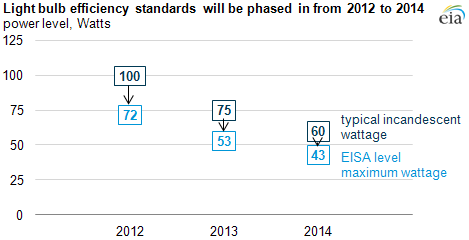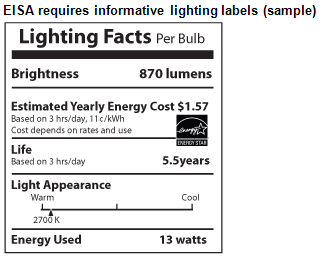
Light bulb standards begin taking effect in 2012

Note: Standards will take effect on January 1 of the years shown.
On January 1, 2012, efficiency standards will start taking effect for brighter, higher-wattage general service bulbs. Based on its light output of about 1,600 lumens, a typical 100-Watt incandescent bulb falls in the first group affected. In the subsequent two years, the legislation will affect groups of relatively dimmer, lower-wattage bulbs. By 2014, most general use bulbs available for purchase will be required to be at least 30% more efficient than traditional incandescent bulbs. These standards, set by Congress in the Energy Independence and Security Act of 2007 (EISA), have already led to significant market transformation for common light bulbs.
The EISA legislation does not affect all bulbs immediately, as bulbs with higher light output levels (measured in lumens) are affected earlier. During 2012, the standard affects bulbs in the range of 1,490 to 2,600 lumens. Based on typical efficiencies, traditional incandescent bulbs in the range of 100 to 150 Watts use about 40% more energy than allowed under the new standard.
Incandescent bulbs below 100 Watts are affected in later years. Bulbs in the 1,050 to 1,489 lumen range (which includes 75-Watt incandescent bulbs) will be affected in 2013, while bulbs in the 310 to 1,049 lumen range (which includes 60- and 40-Watt incandescent bulbs) are not affected until 2014. The legislation also requires these bulbs to have a rated lifetime of over 1,000 hours of active use. Certain bulbs made for special applications are exempt from the efficiency standards.
The 2007 legislation establishing efficiency standards for general service lighting is the first national standard to cover these bulbs, even though lighting is one of the largest end uses in the buildings sectors. Some states already had standards for general service light bulbs; for instance, California established standards made effective in 2001 and 2005, and also implemented the EISA standard a year early.
Incandescent bulbs produce much more heat than light and have remained relatively unchanged for over a century. Even though the efficiency standard has not yet been made effective, it has already changed the lighting market of general service bulbs. In anticipation of the standards, purchases of more efficient types, such as compact fluorescent lamps (CFLs), light-emitting diodes (LEDs), and halogen-based incandescent bulbs have increased recently. EIA projects that these more efficient types will be purchased in roughly equal proportions in the future.
Other nations have also taken part in the market transformation towards more efficient lighting. Most recently, China announced a ban on imports and sales of most incandescent bulbs starting in October 2012.
Another aspect of the EISA legislation is improved labeling for all bulb types. New labels show the bulb's brightness in lumens, power draw in Watts, rated lifetime, light appearance (also known as color temperature) and estimated annual energy cost. These labels (see below for a sample) should allow quick comparison among several light bulb options, as various lighting technologies can provide similar light output with different levels of power needed.
